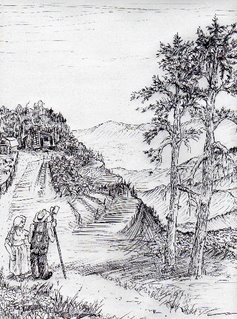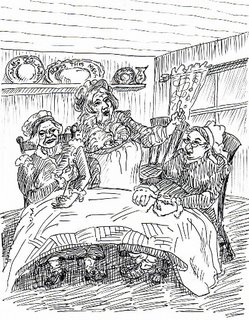Ferradiddledumday
One of my New Year’s resolutions is to try to get a commercial publisher interested in “Ferradiddledumday,” my Appalachian version of “Rumpelstiltskin.”
Actually “Ferradiddledumday” is a Blue Ridge story, but the Blue Ridge Mountains are part of the Appalachians, so technically I have an Appalachian story that incorporates Blue Ridge Mountain plants, animals, superstitions, and farm life into a story for ages 8 and older.
Created in 1998 as an oral presentation about Blue Ridge culture, “Ferradiddledumday” has been presented at schools in three Virginia counties. A very early version was published as a short story in Blue Ridge Traditions.
In 2000, Dr. Tina Hanlon, Ferrum College professor of children’s literature and editor of ALCA-lines, posted “Ferraddidledumday” on her AppLit web site. Tina, who still maintains the AppLit site, used it in a graduate course she taught at Hollins University in Roanoke in 2005. She’s invited me to be a panelist at the Children’s Literature Association Conference at Christopher Newport University in June 2007. According to Tina’s proposal, “Each writer will discuss briefly her approach to writing about Virginia history and culture in fiction for children and young adults, followed by discussion among the writers and audience about writing regional and historical children’s books.”
I’ll talk about the stories in my POD book, Where There’s A Will (Infinity Publishing, 2005), but I surely would love to be able to say that "Ferradiddledumday" will be in print soon.
Teachers across the country have used the AppLit version in their classes—including Ellijay Primary School in Georgia and Mountain City Elementary School in Tennessee. Even a library in Denver, Colorado, used it in a “Rumpelstiltskin” exhibit.
Since I wrote the original version in 1998, I’ve made several changes, and it’s a much better story. An artist friend and member of my Lake Writers group, Bruce Rae, has done some wonderfully edgy pen and ink illustrations.
To make a 3,800 word story short, here’s what happens: A hailstorm destroys a mountain family’s tobacco patch. Gillie, a skilled spinner of wool, worries how she and her pa will raise money to pay their taxes. A strange little man gives Gillie the power to spin hay into gold, and the gold pays the taxes. Gillie marries a fiddle-playing man that she meets on court day in town, they have a daughter, and Gillie leads a charmed life in their mountain cabin until the strange little man returns to collect on her debt. She must guess his name, or he’ll take her daughter. On her last chance, Gillie guesses his name is Ferradiddledumday. He turns many colors before he crumbles into dust at her feet. Gillie dyes her wool all the colors he turned and knits garments for her family. They live happily ever after.
Now, here’s a sample:



. . . and that’s my opening.
I could go the POD route or self-publish, but those methods work better for a tiny niche market. Appalachian literature is a big market. Schools in places far away from me are already using “Ferradiddledumday” in classes—a demand is already out there, so a commercial publisher that could get the story into bookstores all over the country would be a better choice than a do-it-myself route.
If I self-publish, I could expect to sell a few hundred copies. I want to sell thousands and thousands. Am I too ambitious, or what?
Actually “Ferradiddledumday” is a Blue Ridge story, but the Blue Ridge Mountains are part of the Appalachians, so technically I have an Appalachian story that incorporates Blue Ridge Mountain plants, animals, superstitions, and farm life into a story for ages 8 and older.
Created in 1998 as an oral presentation about Blue Ridge culture, “Ferradiddledumday” has been presented at schools in three Virginia counties. A very early version was published as a short story in Blue Ridge Traditions.
In 2000, Dr. Tina Hanlon, Ferrum College professor of children’s literature and editor of ALCA-lines, posted “Ferraddidledumday” on her AppLit web site. Tina, who still maintains the AppLit site, used it in a graduate course she taught at Hollins University in Roanoke in 2005. She’s invited me to be a panelist at the Children’s Literature Association Conference at Christopher Newport University in June 2007. According to Tina’s proposal, “Each writer will discuss briefly her approach to writing about Virginia history and culture in fiction for children and young adults, followed by discussion among the writers and audience about writing regional and historical children’s books.”
I’ll talk about the stories in my POD book, Where There’s A Will (Infinity Publishing, 2005), but I surely would love to be able to say that "Ferradiddledumday" will be in print soon.
Teachers across the country have used the AppLit version in their classes—including Ellijay Primary School in Georgia and Mountain City Elementary School in Tennessee. Even a library in Denver, Colorado, used it in a “Rumpelstiltskin” exhibit.
Since I wrote the original version in 1998, I’ve made several changes, and it’s a much better story. An artist friend and member of my Lake Writers group, Bruce Rae, has done some wonderfully edgy pen and ink illustrations.
To make a 3,800 word story short, here’s what happens: A hailstorm destroys a mountain family’s tobacco patch. Gillie, a skilled spinner of wool, worries how she and her pa will raise money to pay their taxes. A strange little man gives Gillie the power to spin hay into gold, and the gold pays the taxes. Gillie marries a fiddle-playing man that she meets on court day in town, they have a daughter, and Gillie leads a charmed life in their mountain cabin until the strange little man returns to collect on her debt. She must guess his name, or he’ll take her daughter. On her last chance, Gillie guesses his name is Ferradiddledumday. He turns many colors before he crumbles into dust at her feet. Gillie dyes her wool all the colors he turned and knits garments for her family. They live happily ever after.
Now, here’s a sample:
Once upon a long-ago time, high on the side of one of the mountains in the Blue Ridge, lived a poor farmer and his blue-eyed, yellow-haired daughter. Exactly whereabouts they lived is hard to say, for the Blue Ridge Mountain range extends all the way from Pennsylvania to Georgia, but word has they lived somewhere in southwestern Virginia.

This man and his daughter were very poor, but like everyone else in the mountains, they made do with what they had. They kept a cow and an old horse, tended a garden, planted a little tobacco for their cash crop, and raised a few pigs and a few sheep. The daughter, whose name was Gillie, tended the sheep, sheared them herself, washed and carded their wool, spun the wool into fine yarn, and knitted the yarn into fine garments—socks and mittens and warm mufflers—for her old pa and herself to wear. The wool she spun was the finest anybody on the mountains had ever seen.
“Takes charmed hands to spin wool that fine,” an old granny woman once said to another at a quilting. Soon one told another who told another, and word spread among the mountain folk that might be Gillie led a charmed life.

Indeed, when she took her sheep down the rocky and wooded mountainside to the bottom-land pasture, the ticks and chiggers never bit her, the copperheads and rattlesnakes kept themselves hid, and the wild panthers that were said to lurk on the mountain gave her a wide berth. The sun never shone on her too hard and the rain rarely wet her.

In early spring, it seemed as if the redbuds and the dogwoods bloomed just for her; and just for her the shy pipsissewa peeked out from the forest floor. The maidenhair ferns caressed her as she walked by them, and the dogtooth violets seemed to beg her to pick them.
. . . and that’s my opening.
I could go the POD route or self-publish, but those methods work better for a tiny niche market. Appalachian literature is a big market. Schools in places far away from me are already using “Ferradiddledumday” in classes—a demand is already out there, so a commercial publisher that could get the story into bookstores all over the country would be a better choice than a do-it-myself route.
If I self-publish, I could expect to sell a few hundred copies. I want to sell thousands and thousands. Am I too ambitious, or what?

1 Comments:
Not too ambitious. Go for it. I wish I had your tenancity and courage. You shame me every time I read about your efforts.
Post a Comment
<< Home